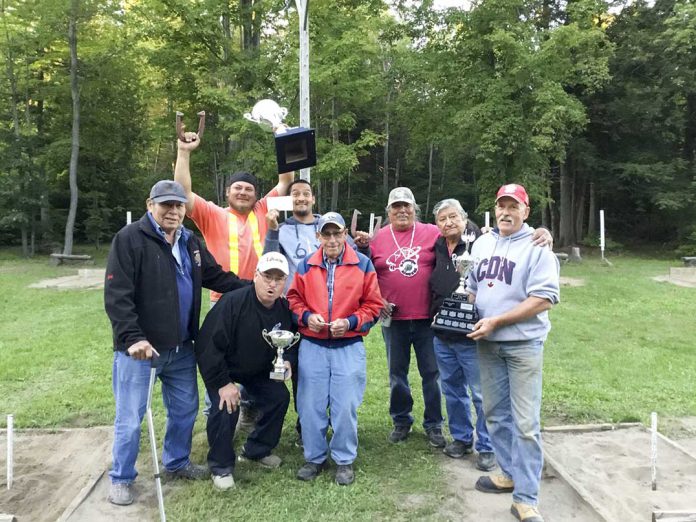MINDEMOYA—The two human skulls found in Mindemoya a couple of years ago, that were determined to be between 800-900 years old, are now being shipped to the municipality with final disposition being discussed with the M’Chigeeng First Nation.
At a Central Manitoulin office and administration committee meeting August 28, Central Manitoulin CAO/Clerk Ruth Frawley spoke of the human remains that had been found in Mindemoya. She expressed her gratitude in that there will not be a need to do a study that is often carried out in these type of situations.
“Yes, we were given notice from the office of Nancy Watkins, Registrar, Funeral, Burial and Cremation Services Act, 2002, Licensing, Inspections and Investigations Branch with the Ministry of Government and Consumer Services that we don’t have to carry out a study that we had been told previously that we would have to,” Ms. Frawley told the Recorder on Tuesday.
As was reported in 2016, a moss-encrusted human skull that had rolled down a hill and through forest debris lining a Mindemoya path to land wedged against a tree had been first discovered by Mindemoya nature photographer Jamie Pyette and another was found in the same area as the first. Subsequently, a report came back from a forensic facility in the US where the skulls had been sent for analysis. It was found that the person whose remains were discovered in May 2016 was thought to have walked the earth some 800 to 900 years ago. The skull was centuries old. That age dates the skull to long before first contact between First Nations and Europeans took place.
The skull most likely belonged to an adult male and to add to the mystery, it was believed the skull’s original resting place was not where it was eventually discovered. The plant life on the skull and the fact of its survival through the near-millennium since the death of its owner, mitigate against the remains having been exposed to the elements for a significant period of time.
As well, a second skull had been found near the first one that was also estimated to be about 800-years-old.
The study Ms. Frawley mentioned was to be a study carried out by a qualified archaeologist, stage 1-3 burial site investigation. Central Manitoulin had looked into this and had gotten quotes for this work to be carried out. The lowest bid would have been $54,525 plus HST and the highest hid was $67,165.
However, Ms. Watkins gave us a declaration that this was an irregular burial site, (so it does not have to be declared a cemetery) and the municipality doesn’t have to do the study, Ms. Frawley told the Recorder. “She (Ms. Watkins) had accepted the anthropologist study that had been done the day after the skull had been identified (carried out by Scott Fairgrieve, chair of the Department of Forensic Science at Laurentian University and a consulting forensic anthropologist),” said Ms. Frawley. She noted the municipality had contacted MP Carol Hughes and MPP Michael Mantha on the issue due to the potential costs to the municipality for the study.
Harry Malhi, Strategic Issues and Media Advisor Communications Branch with the Ministry of Government and Consumer Services said in an email to The Recorder Tuesday, “On July 27, the Registrar (Ms. Watkins) declared that the burial site discovered in May of 2016 was an irregular burial site and provided notice to the landowner (municipality), who now must ensure that the remains are interred in a cemetery. The Registrar also provided notice of the declaration to the chief of a local First Nation, so they have an opportunity to provide input into where and how the remains should be interred.”
Mr. Malhi explained, “in May 2016, an incomplete cranium was discovered by a young man along the base of a small ridge near the Town of Mindemoya. Following investigation, nine fragments of a second cranium were discovered approximately five metres southwest of cranium #1. The Coroner notified the Registrar in May 2017 of the burial site discovery. In May 2018, the Registrar determined that the remains were not intentionally buried at the site.”
In a letter to Ms. Frawley and Linda Debassige, chief of M’Chigeeng First Nation, Ms. Watkins wrote in part, “Notice of Declaration Provided Pursuant to Section 177 of Ontario Regulation 30/11 (the Regulation), made under the Funeral, Burial and Cremation Services Act, 2002 (the Act). In accordance with the provisions of the Act, please find attached the Notice of Declaration which declares the above-noted burial site (Burial site discovery on Lot 22, Concession 5, north half, Plan 31R-1369-Part 1, Town of Mindemoya, Central Manitoulin Township, Manitoulin District, Province of Ontario) to be an “irregular Burial Site.”
“Please take notice that Ruth Frawley is notified in her capacity as representative of the Municipality of Central Manitoulin, the owner of the land on which the Irregular Burial Site is located. You must now ensure that the remains are interred in a cemetery located in your municipality or in an adjoining local municipality, or establish the site, or land in close proximity to the site, as a cemetery.”
“I understand that these remains are currently at Ontario’s Centre of Forensic Science,” continued Ms. Watkins. “As such, I have also copied Dr. Kathy Gruspier, a Forensic Anthropologist at the Office of the Chief Coroner and the Ontario Forensic Pathology Service. Dr. Gruspier will be able to assist with the process for transferring these remains back to Mindemoya so they can be re-interred.”
Mrs. Frawley is now waiting to hear from M’Chigeeng First Nation Chief Linda Debassige to see if M’Chigeeng wants to do the burial of the remains as they are First Nation.





